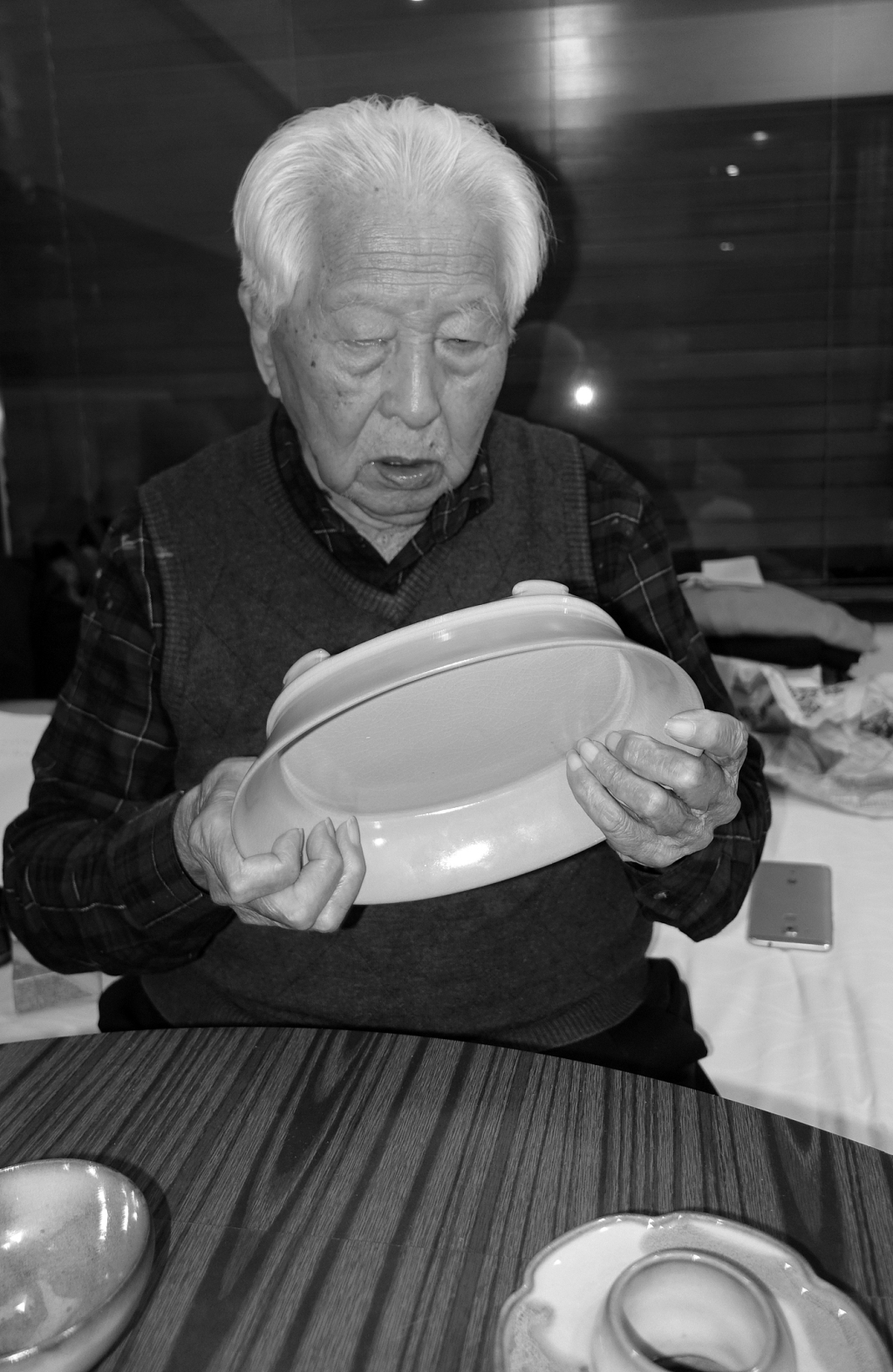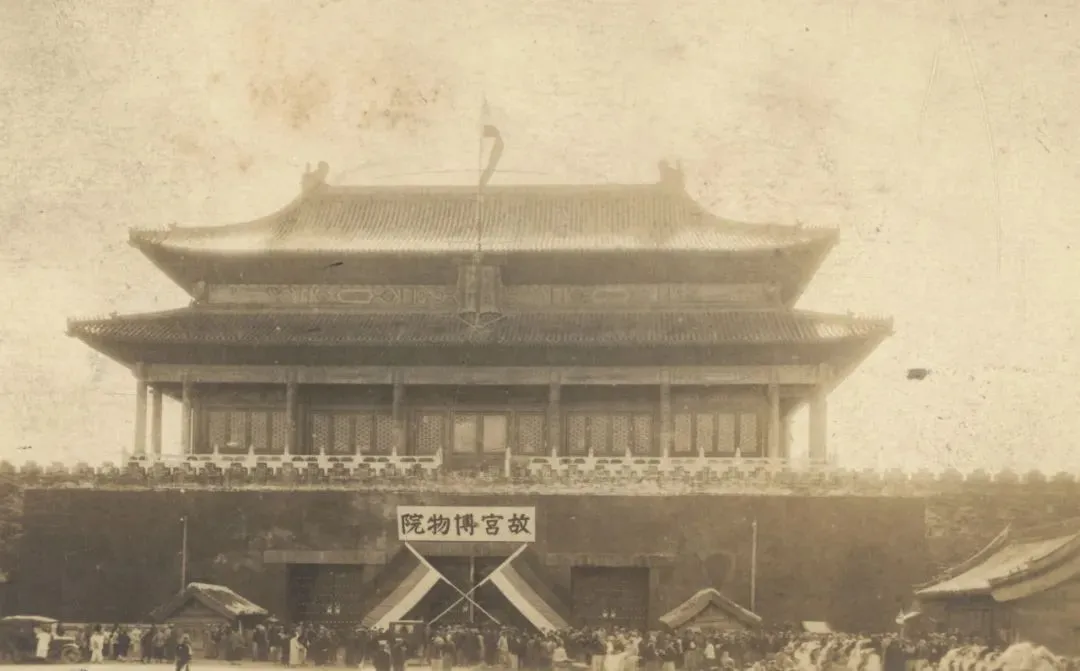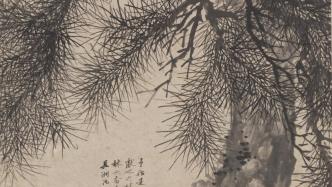
On the fourteenth day of the winter month of the lunar calendar, there is heavy snowfall in the twenty-four solar terms. "The big one is full. So far, the snow is full."
"The heavy snow presses down on the green pine, and the green pine is straight and straight." This solar term is the best time to appreciate the pine. In the calligraphy and painting of the past dynasties, there are so many masterpieces of painting pine, and "pine" has obviously become a common material in traditional culture that contains rich humanistic images, and its styles are diverse. For example, Yuan Wangyuan's "Pine Pavilion Meeting Friends" has a sharp and subtle brushwork, and the brushstrokes are solid, without any hesitation. It seems to be directly from the Song Dynasty; Rusty and inadvertent, but extremely calm and powerful; Qing Dynasty Zhao Zhiqian's "Mo Songtu" axis, the calligraphy on the painting is powerful and vigorous, and its gold and stone charm complements the painting method of pine wood, full of interest.
"When it's cold, you know the pines and cypresses will wither." In this midwinter season, "The Paper·Ancient Art" sorts out the pictures of ancient pines in the collections of the National Palace Museum and the National Palace Museum in Taipei for readers.
Song, Li and Tang Dynasties Songfeng Picture Axis

Song, Li and Tang Dynasties Ten Thousand Valleys and Pine Winds Axis Collection of the National Palace Museum, Taipei
Li Tang (about 1049-1130), born in Heyang, with the style name Xigu. In the Huizong Dynasty of the Northern Song Dynasty, he worked in the Hanlin Academy of Painting. After the Jingkang disaster, the Central Plains was in chaos, and Li Tang crossed the river to Hangzhou during the Jianyan period. During the Shaoxing period of the Southern Song Dynasty, Emperor Gaozong rebuilt the Academy of Painting, and Li Tang re-entered the Academy of Painting, awarded Cheng Zhonglang, waited for the Academy of Painting, and bestowed a gold belt.
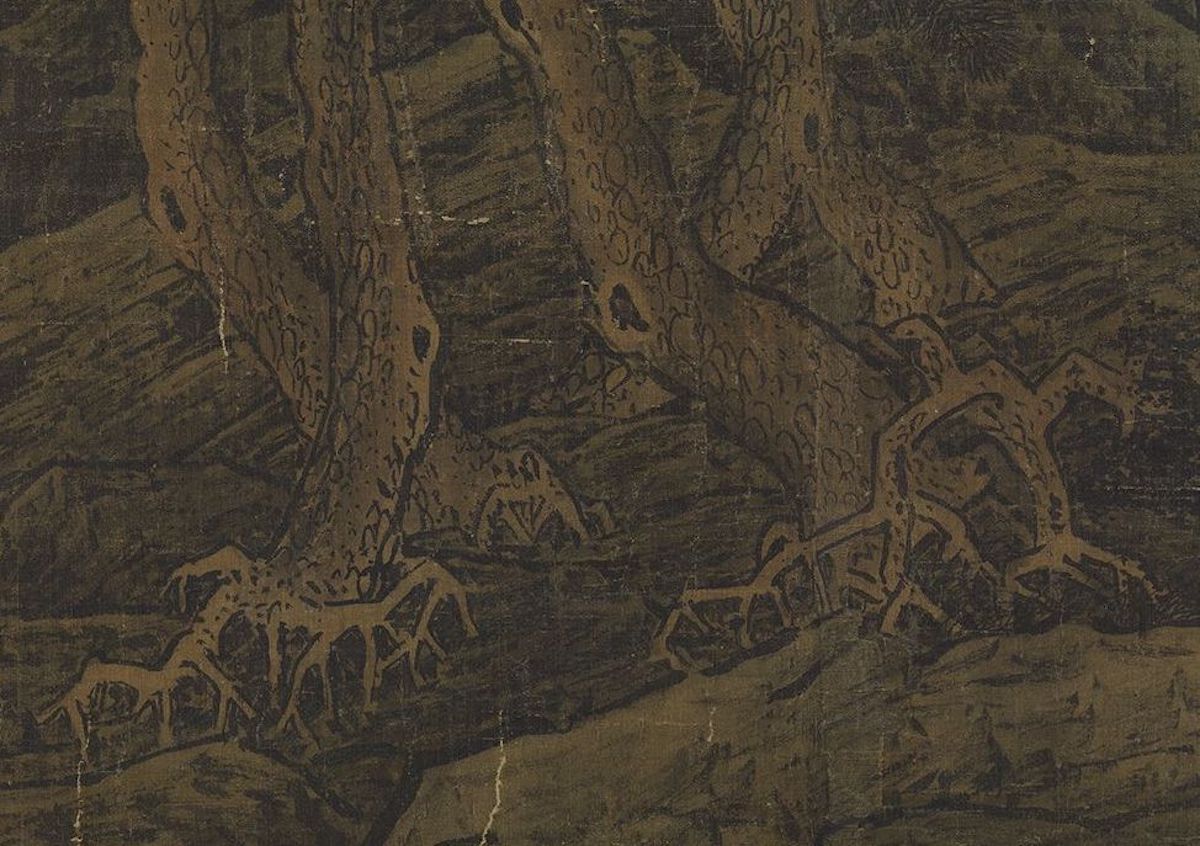
Axis of Song, Li and Tang Dynasties with Pines and Winds (Partial) Collection of National Palace Museum, Taipei
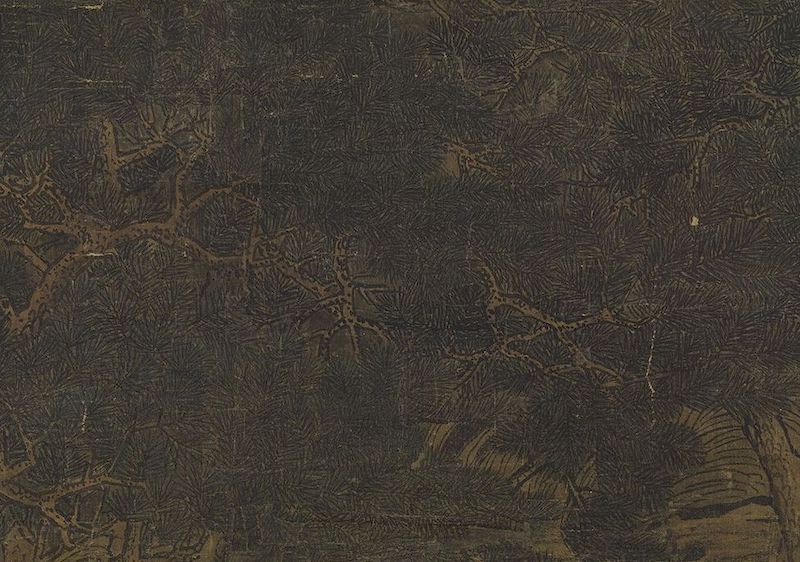
Axis of Song, Li and Tang Dynasties with Pines and Winds (Partial) Collection of National Palace Museum, Taipei
This painting is another masterpiece of landscape painting in the Northern Song Dynasty after "A Journey Through Streams and Mountains" and "Early Spring", which represents another glorious stage of landscape painting. On the steep and distant mountain next to the main peak, there is an inscription "Emperor Song Xuan and Jiachen Chunheyang Li Tang Pen". At this time, it was the sixth year of Xuanhe in the Northern Song Dynasty (1124). The momentum still shocks the viewers. The main peak in the painting is arranged in the center of the picture, and there are cloud-cutting peaks of varying heights on both sides. No matter the hills or cliffs, the shape is calm and heavy, the rock surface is hard, and the texture is like being chiseled by an axe. It is called "axe splitting". The composition of the painting adopts a high and distant form, which makes the whole painting have a solemn atmosphere. However, Li Tang enlarged the proportion of the foreground trees and narrowed the main peak in the composition, so that the distance between the foreground pine forest and the viewer is closer, and the spatial structure is more reasonable. Li Tang's painting style inherits the past and inspires the future, and it has actually opened the forerunner of the close-up landscape in the Southern Song Dynasty.
Song Malin Quietly Listening to the Wind in the Pine Trees
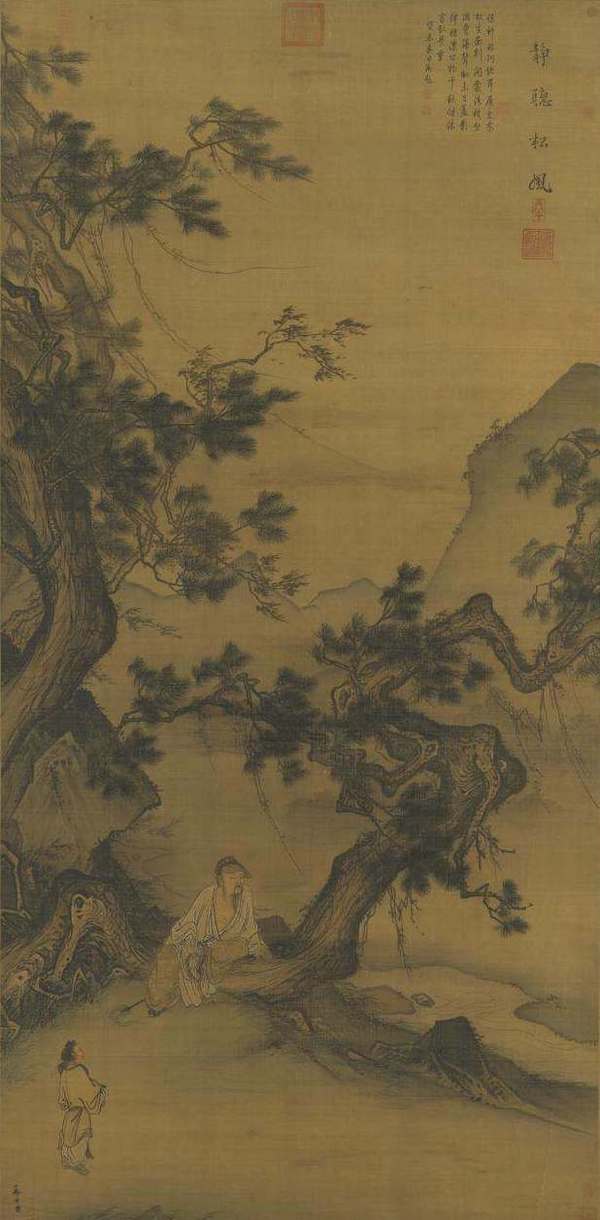
Song Malin Listening to the Wind in the Pine Trees, Collection of the National Palace Museum, Taipei
Ma Lin (13th century AD), born in Hezhong (now Shanxi Province), later moved to Qiantang, Zhejiang, son of Ma Yuan. Due to his family background, he is good at landscapes, figures, flowers and birds. His sketches have their own style, which does not mix with his father's style, and maintains an independent position in the history of painting.

Axis of Song Malin Listening to the Wind in the Pine Trees (partial) Collection of the National Palace Museum, Taipei
Painting Gao Shi resting among the pine trees, the pine branches are biased to one side by the wind, and a boy is waiting beside him. Gu Kaizhi, a great painter of the Jin Dynasty, once said: "It is easy to wave five strings, but it is difficult to watch Feihong". This painting vividly expresses the expression of eyes listening intently to Matsukaze.

Axis of Song Malin Listening to the Wind in the Pine Trees (partial) Collection of the National Palace Museum, Taipei
Emperor Gaozong of the Qing Dynasty wrote a poem that the figure in the painting is Tao Hongjing of the Liang Dynasty who "loves the wind of pine trees very much, and takes pleasure in hearing its sound". Some scholars compared Lizong's portrait and believed that this painting presents the image of Lizong Aisong.
Song Dynasty Rock Spring Rock Axis
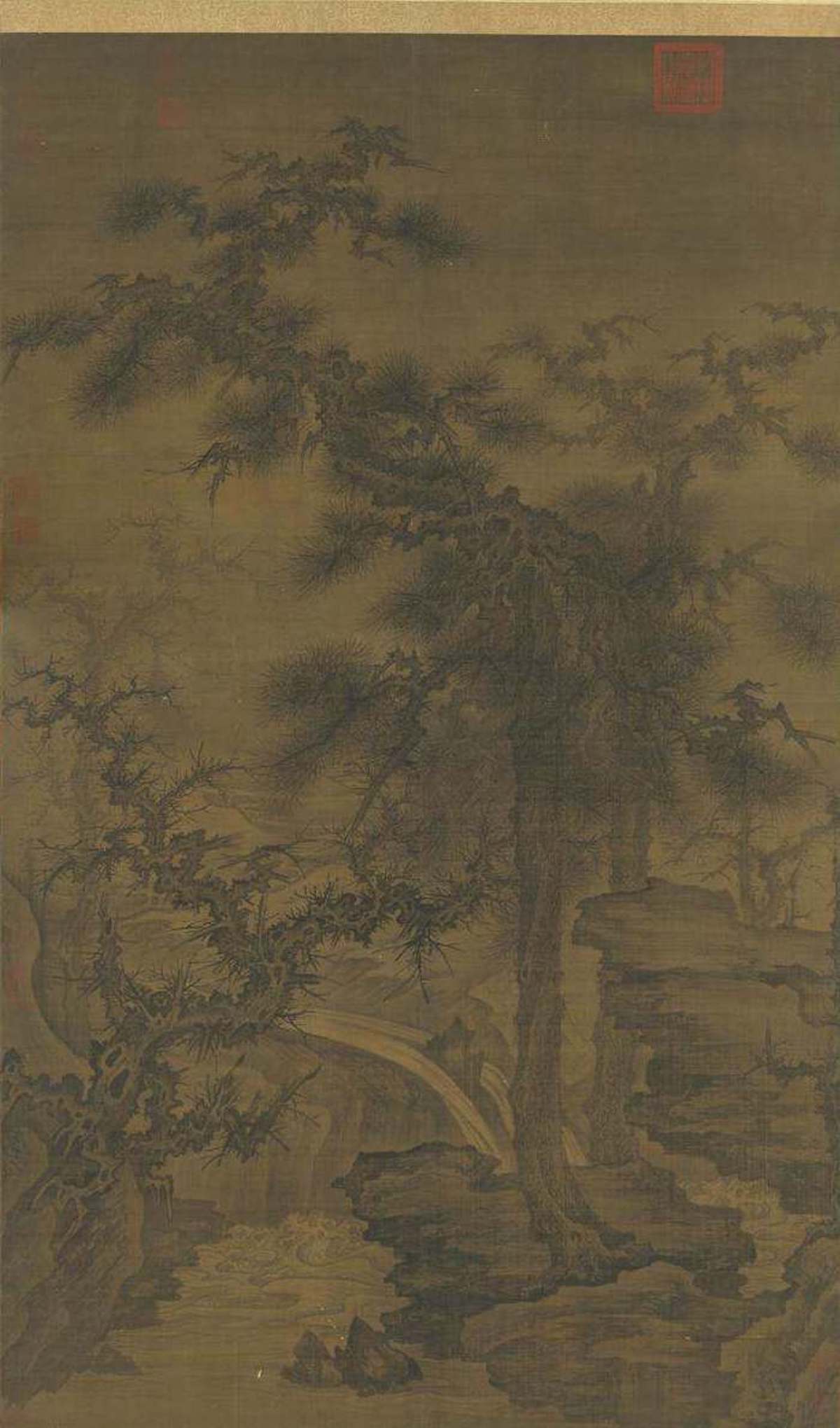
Pine Spring and Rock Axis from the Song Dynasty in the National Palace Museum, Taipei
The subject matter and style of this painting belong to the works of "Song Shi Ge". It depicts a pair of pines standing upright on a rock, accompanied by dead trees on both sides, and it also has the scene of a cold forest. Behind the cold forest, you can vaguely see the clear ravine zigzag, rushing down to the rock, stirring up whirlpools and waves. Songshige is a painting that emerged in the eighth century, or painting "pine stones" or "tree stones", including pines, cypresses and other trees. It is a part of the scope of landscape painting, and further developed, it is related to the "cold forest" picture. Li Cheng (919-967) was good at painting the landscapes of North China, especially the sparse and desolate cold forests. Guo Xi (activated in the second half of the eleventh century) continued to develop, and gradually formed the "Li Guo" series of landscape paintings, and the cold forest painting became a very popular theme in the Song Dynasty (960-1279). In the Song Dynasty, it was developed by Wen Tong (1018-1079) and Su Dongpo (1036-1101) and others, and a new theme of "ancient wood, bamboo and stone" was formed in the Yuan Dynasty.
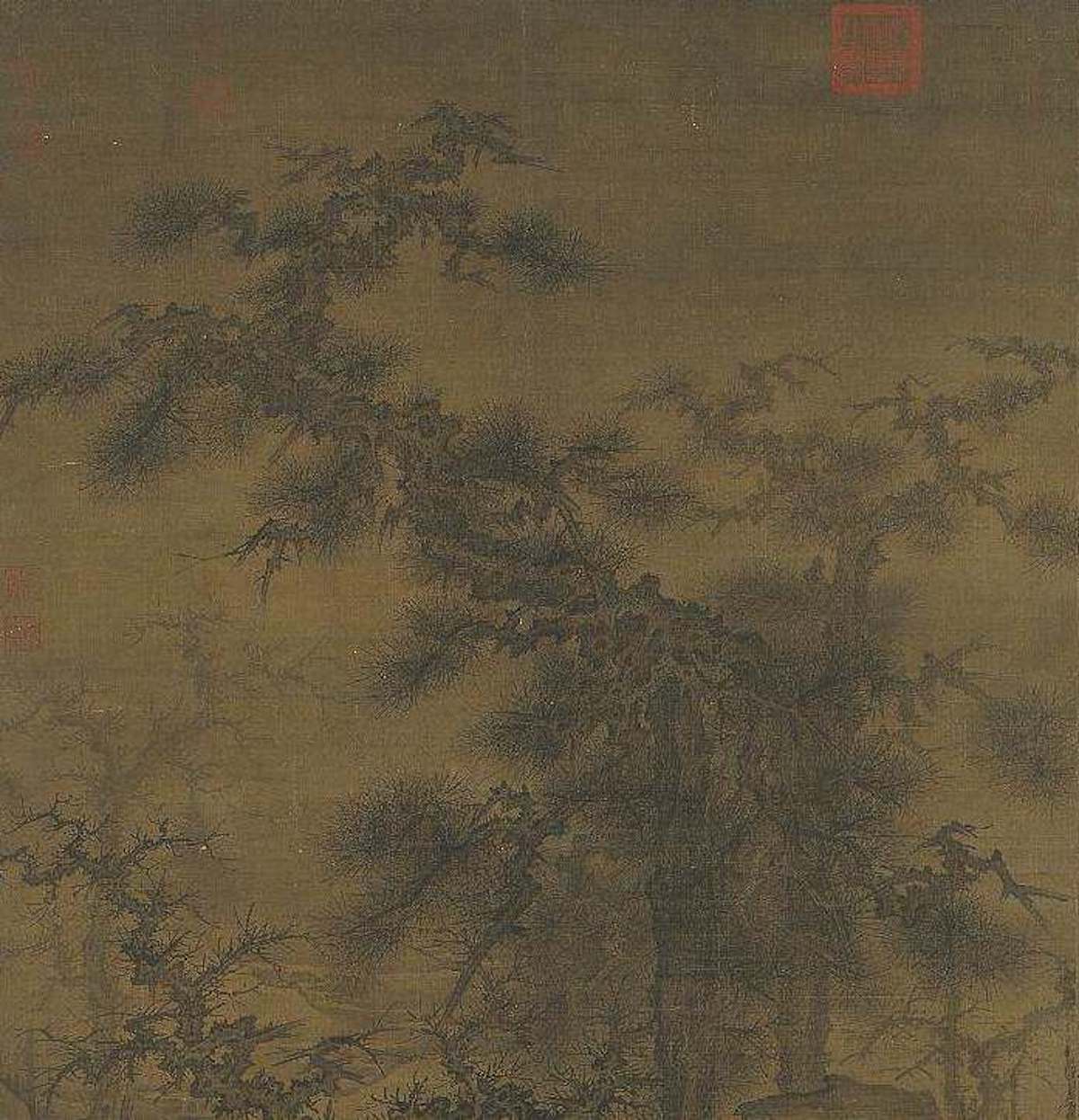
Pine Spring and Rock Axis from the Song Dynasty (partial) Collection of the National Palace Museum, Taipei
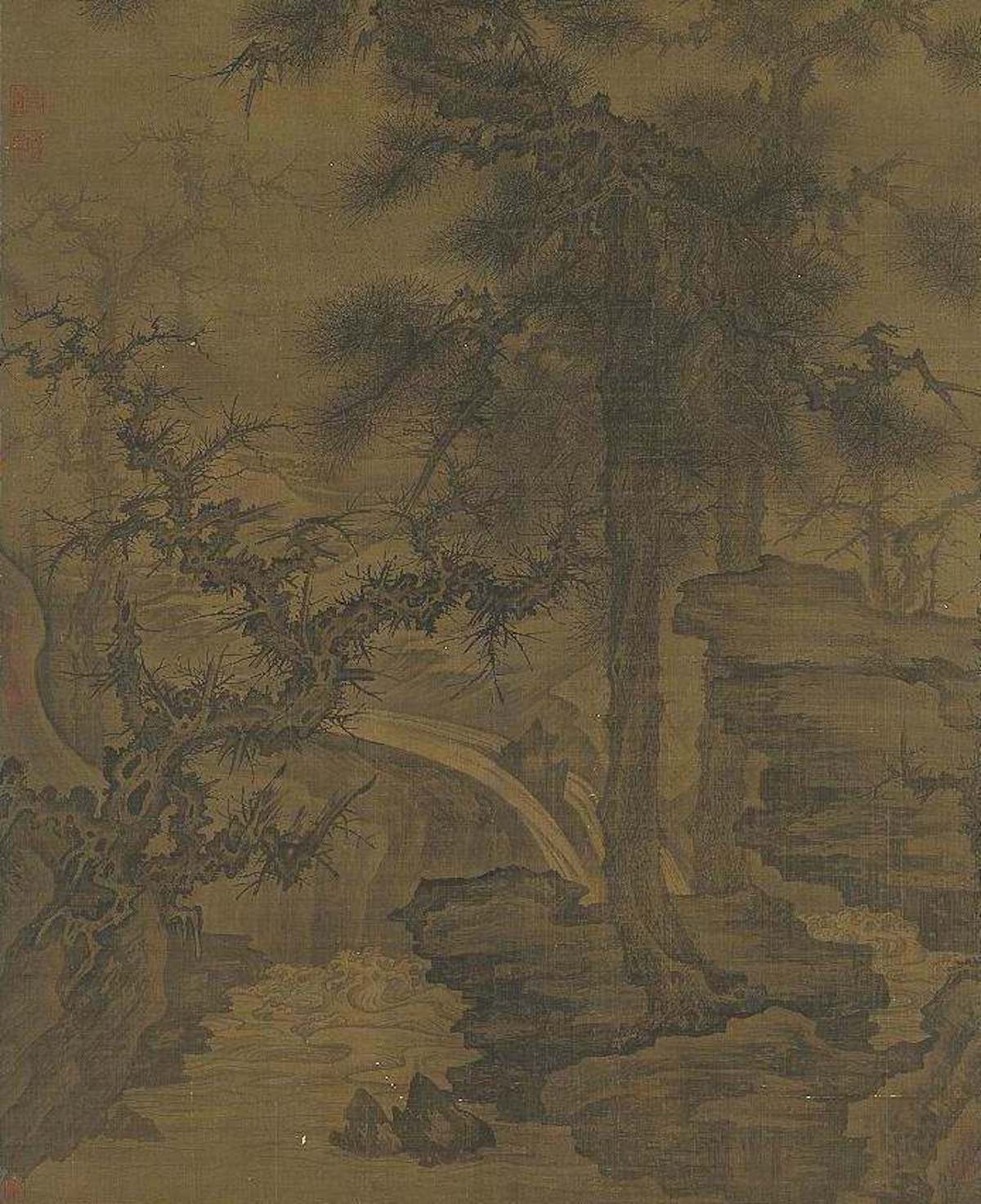
Pine Spring and Rock Axis from the Song Dynasty (partial) Collection of the National Palace Museum, Taipei
This painting of pine trees and ancient trees not only emphasizes the numerous galls, but also repeatedly repeats the state of turning branches. Compared with the "Arbor Map of the Song Dynasty", the twisting and turning of the branches in this painting tends to be more formal. This style of painting is about the middle and late period of the Southern Song Dynasty (1127-1279), and it is similar to the Ma Xia school's emphasis on the fun of brush and ink. The mood of painting the branches is like using the brush to write calligraphy. Between the depiction of the real image and the expression of chic brush and ink, the painter actually places more emphasis on the latter. There are still many ink dots between the branches and leaves. After writing the branches and leaves, there is still a sense of insufficient ink rhyme. Then use the "ink-playing method" to strike the string of the small bow with the pen, so that the ink dots are sprayed on the painting, forming "Point", "Line", and "Surface" have richer changes.
Axis of Double Pine Trees by Li Jin in the Yuan Dynasty
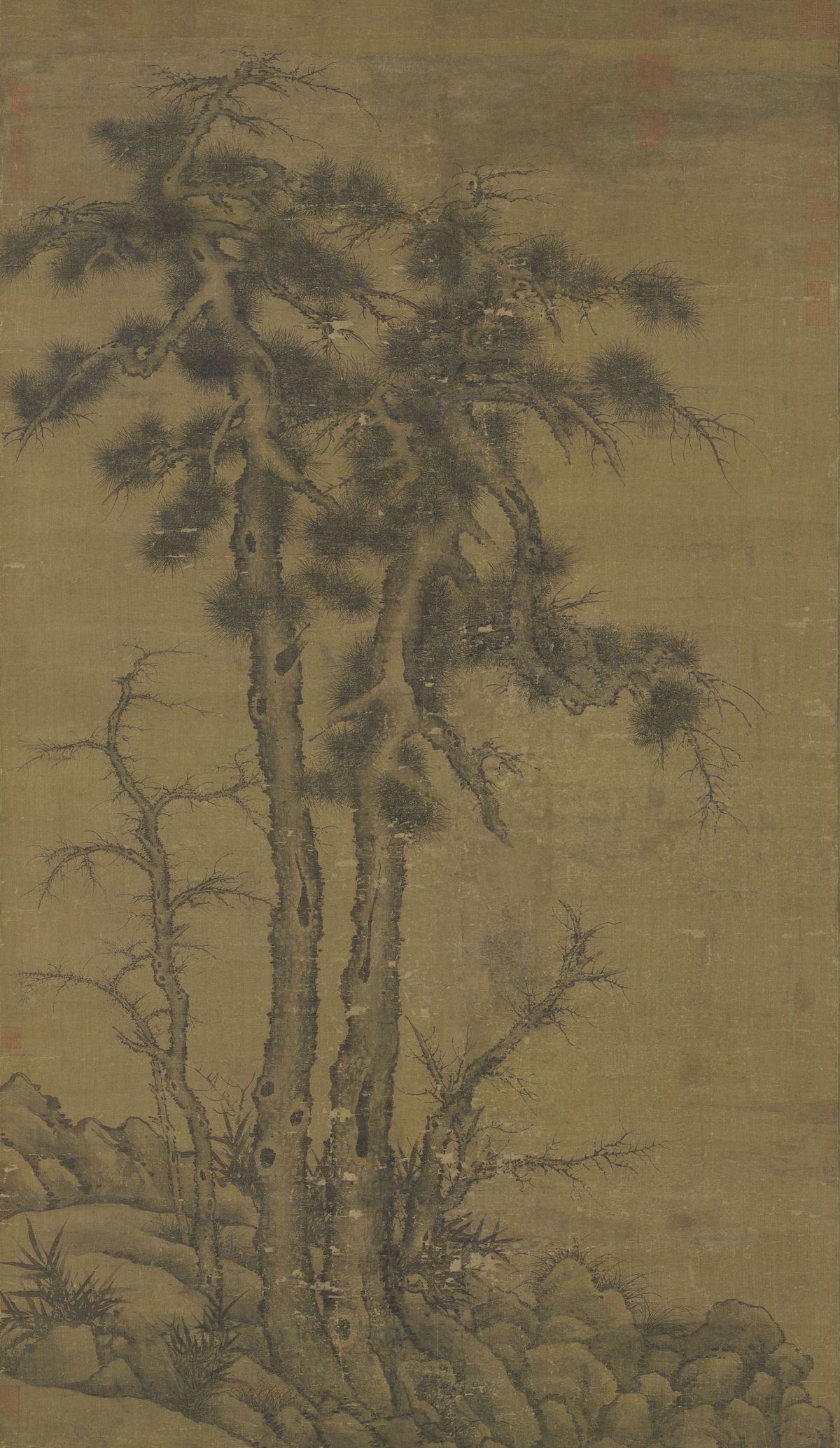
Axis of Double Pine Trees by Li Jin in the Yuan Dynasty Collection of the National Palace Museum, Taipei
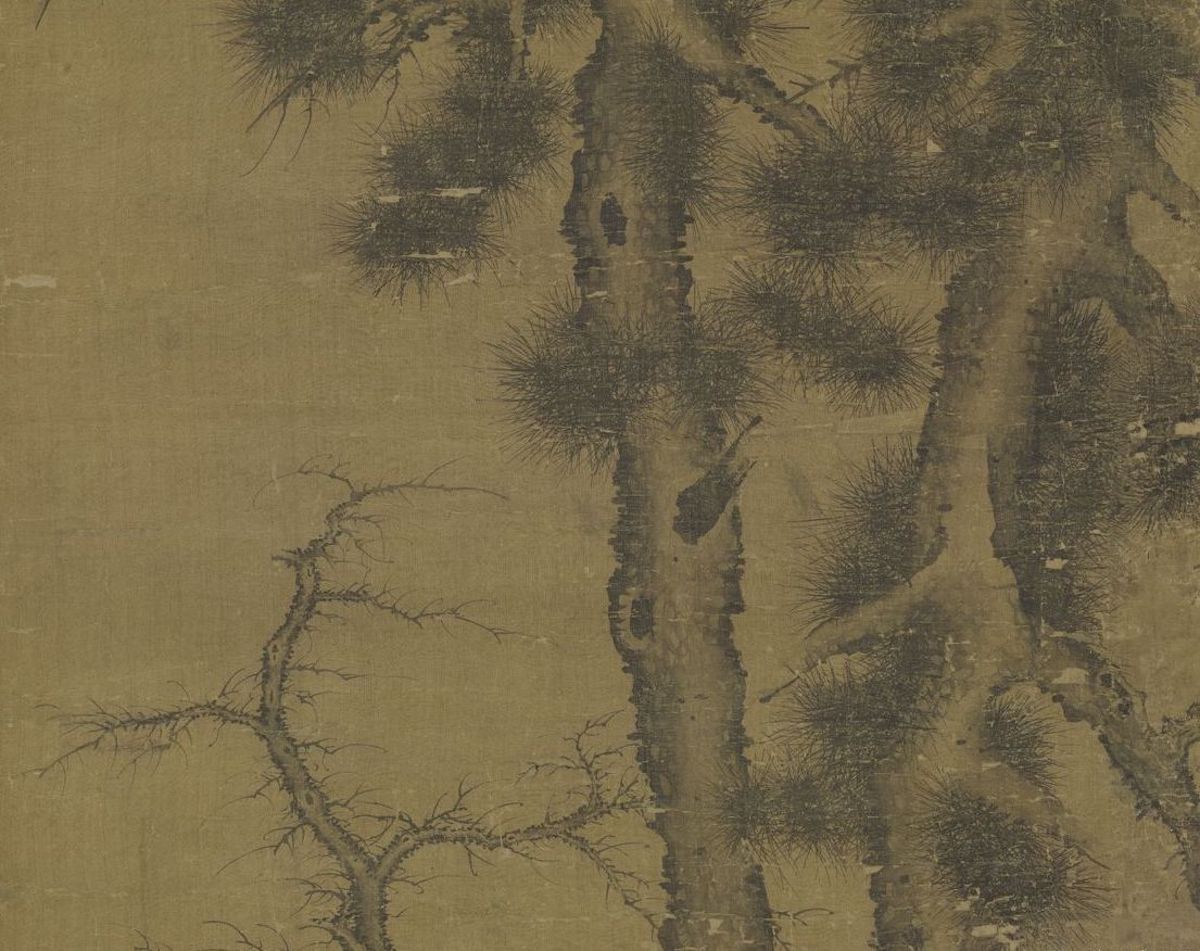
Axis of Twin Pine Trees in Yuan Dynasty (partial) Collection of National Palace Museum, Taipei
Li Jin (1245-1320), a native of Jixian County, Hebei Province. The word is Zhongbin, and the name is Xizhai Taoist. He once went to Jiaozhi as an envoy, went deep into Zhuxiang, and made detailed observations on the ecology of bamboo. He is the author of two scores of "Painted Bamboo" and "Ink Bamboo". The double pines are towering on the slope rocks, and there are still a few dead trees standing beside them, which seems to describe that the grass and trees have withered in the winter, but the branches and leaves of the pine trees are still lush and green. The pine leaves are painted into a spherical shape with a fine brush, and the pine leaves are stained and dyed round and round, giving an elegant and warm feeling. Between the dry trees and rocks on the left side of the painting, there is a seal of "Zhong Bin Geng Zi Xi Zhai".
Yuan Shengmao Pine and Stone Axis

Yuan Sheng Mao Pine and Stone Axis Collection of the Palace Museum
The inscription on the upper left of this painting reads: "On the 22nd day of Zhengjihai and Zhongqiu, Wutang Sheng Mao Zizhao made this picture for Youzhenshou." The lower seal is "Zizhao" and "Sheng Mao" seals. "Zhizheng Jihai" is the 19th year of Zhizheng (1359), and the person "Youzhen" who was painted is unknown. On the lower left of this painting, there are seals in the Jian Jian Collection, "Guangong Read", "Jianyang Book", "Han Yun Collection of Famous Sites of the Yuan Dynasty", "Zi'an Collection".
This picture was made by Sheng Mao, a famous painter in the late Yuan Dynasty, and it is a work for people's birthday. The picture depicts an ancient pine tree, which occupies almost the entire picture, with drooping upper branches and strong pine needles. The hillside is painted with beautiful rocks under the tree, and the stream is flowing, lined with thorns, without background. The painting method is stable, the brush and ink are vigorous and thick, revealing a faint boldness, and there is no lack of nourishing and free spirit of ink and wash. The pine tree painting in the picture is quite distinctive. The trunk is dyed with light ink, and the moss is dotted with thick ink, thus increasing its thickness and the texture of the bark. The pine needles are drawn with fine brush and thick ink. The brushwork is strong, sharp and sharp. It not only has the legacy of the style of the Southern Song Dynasty, but also has its own unique processing method combining handwriting and writing, which is unique. The rocks on the slopes are mainly smudged with ink, with thick ink dotted with moss, rubbed with rubbing, and the mood is vivid.
Yuan Li Shixing Qiao Pine Bamboo Stone Axis

Yuan Li Shixing Qiao Song Bamboo Stone Axis Collection of the National Palace Museum, Taipei
Li Shixing (1282-1328), courtesy name Zundao, was born in Jiqiu, Hebei, the son of Li Jin (1245-1320). He is also good at poetry, calligraphy and painting, and the bamboo and stone he paints are learned from his own family. Against the backdrop of slope stones and bamboo leaves, a pine tree stands proudly. Only two branches have pine leaves, and the rest are dead branches, showing the beauty of the pine trunk. The pen is simple and powerful, loose and full of Teton changes, while bamboo and stone are smooth and moist.
Yuan Cao Zhibai Shuangpine Picture Axis
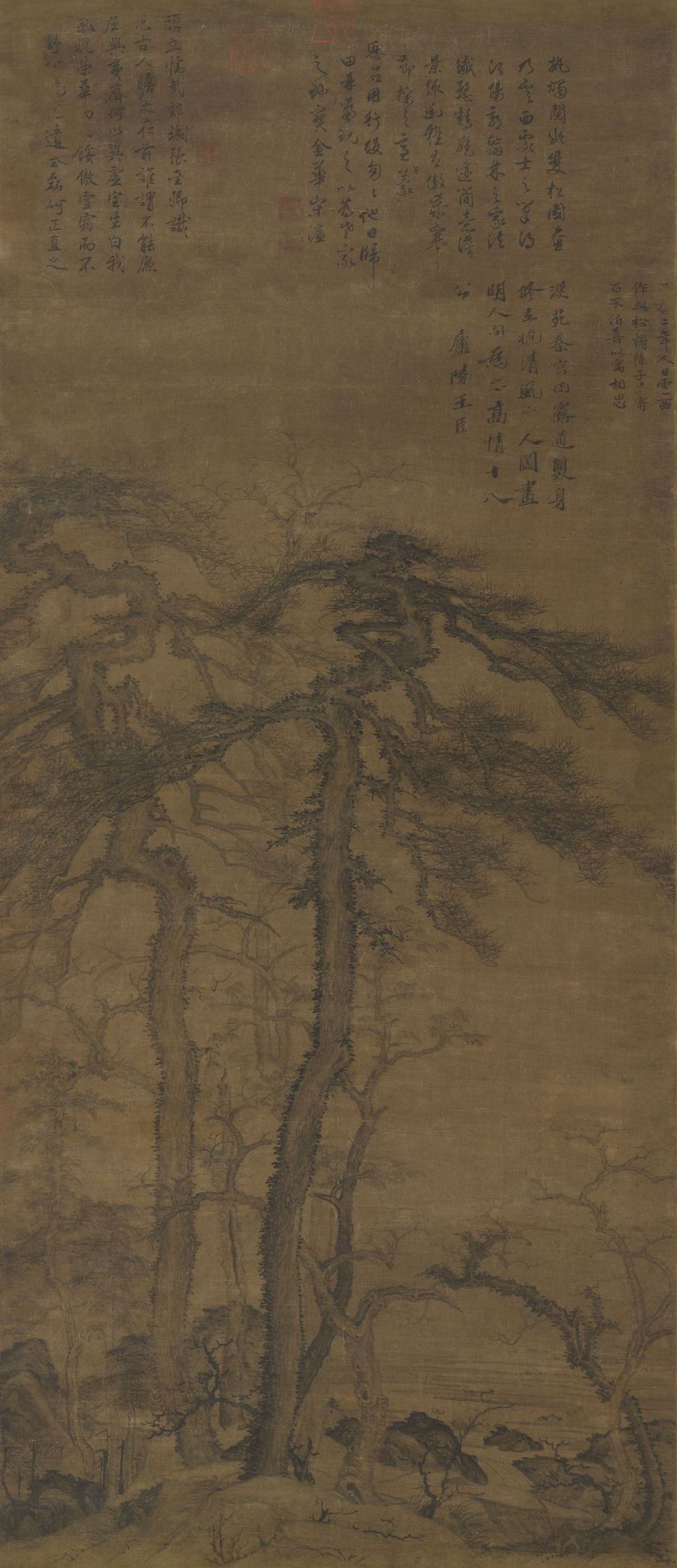
Yuan Cao Zhibai Shuangpine Picture Axis Collection of the National Palace Museum, Taipei
Cao Zhibai (1272-1355), a native of Shanghai. The word is Xuan, and the name is Yunxi. In the first year of the Yuan Dynasty, it was the teaching instruction of Kunshan. He is good at painting landscapes and learned from Guo Xi. On the rocky slope by the water, two pine trees rise from the ground, towering like the sky, backed by miscellaneous trees, hidden in the smoke and mist, gradually getting farther and darker. Standing side by side with two pines, the branches on the top of the trunk stretch out to the surroundings, with distant water on the side, forming an endless scene. The painting was completed in the second year of Tianli (1329), at the age of fifty-eight. The use of pine trees as a key point in landscape painting is probably related to the overall environment of the Yuan Dynasty. The painter used things to express his ambition, and the firmness of the pine trees made the pair of pine trees a symbol of friendship and loyalty. This kind of works are very popular in Yuan paintings. Such as the works of Zhu Derun, Tang Di and others.

Axis of Cao Zhibai Pine Trees in Yuan Dynasty (partial) Collection of National Palace Museum, Taipei
Looking at the double pine trees of various families, one can find the rigorous tradition of describing trees and stones held by the Li Guo School since Li Jin. However, compared with the slightly calligraphically exaggerated pine trees in Zhujia's works, the shape of the tree and the use of brushes show a plain personal style. The painter uses straight lines and scales to express the loose and dry skin, and adds horizontal moss on the tree body, which looks neat and regular, but the twists and turns of the pine branches are stretched, the branches are turned and raised, and the fine lines are scattered in all directions. Loose pine needles break the flatness of the loose body. The dead branches of miscellaneous trees are painted with crab-claw brushwork. Compared with the simple and light brushwork with three pines in the foreground of "Picture of Snowy Peaks" made by him in his later years when he was seven or nine years old, the brushwork in this painting appears rigorous and thick.
Axis of Yuan Wang Yuansong Pavilion Meeting Friends

Yuan Wang Yuansong Pavilion Meeting Friends Picture Scroll Collection of the National Palace Museum, Taipei
Wang Yuan was born in Qiantang (now Hangzhou), Zhejiang. The word is Ruoshui, and the name is Tanxuan. When he was young, he studied Danqing and was taught by Zhao Mengfu. Its flower and bird master Huang Quan, landscape master Guo Xi, and characters from Tang Dynasty, are all exquisite. This painting was completed in the third year of Daedeok (1299). Paint the shore of Songzhi, the pavilion is safe on the water, one host and one guest, and the other five boats are floating on the river. The pen is sharp and reserved, the pen is solid, without any hesitation, it seems that it can be directly from the people of Song Dynasty.
Axis of Yunsong Map in Bayanbuha Ancient Valley, Yuan Dynasty

Yuan Bayan Buha Ancient Valley Cloud and Pine Map Axis Collection of the National Palace Museum, Taipei
Bayan Buha (unknown date of birth, died in 1359), a biography in the history of the Yuan Dynasty as Boyan Buhua's Jin. Mongolian, surnamed Weiwuershi, the grandson of King Gaochang. The word Cangyan, the name Cangya. He is the nephew of Xian Yushu, a great calligrapher of the Yuan Dynasty. The official went to Jiangdong Lian to visit the deputy envoy. Proficient in music, famous for painting dragons. The composition of this picture is very prominent, the pines are towering, and the peaks and mountains stand out from the clouds. The pen and ink are quite interesting in literati painting.
Ming Daijin Mosong Scroll

Ming Daijin Mosong Scroll (partial) Collection of the Palace Museum
The signature of this volume is "West Lake Jing'an Pen", and the seals are "Qiantang Daishi", "Wenjin", and "Zhuxue Study". "Zhuxue Study Room" is the name Dai Jin used when he was in Beijing. From the seal on the picture, it can be seen that this picture should be made by Dai Jin during his stay in Beijing. This picture inherits the tradition of literati ink painting in the Song and Yuan Dynasties, and uses a more relaxed ink brushwork method to draw specific and real objects. The ink color is rich in shades and layers, and the contrast between dry and wet is sharp. Lost personal pen and ink style painting appearance.
This picture is bound together with Zhu Kongyang's "A Picture of Misty Rain on the Xiangjiang River".
Axis of ancient pine in Ming, Shen and Zhou dynasties

Axis of Ancient Pine Trees of Ming, Shen and Zhou Dynasties Collection of National Palace Museum, Taipei
Shen Zhou (1427-1509), a native of Changzhou, Jiangsu. The word is Qinan, the name is Shitian, and the name is Baishiweng. He is generous and magnanimous, capable of poetry and calligraphy, not only good at painting landscapes, but also flowers, fruits, feathers, etc. An old pine tree, coiled with vines, the main branch on the left is inclined from right to lower left, almost parallel to the main trunk, which is quite interesting. The composition of the picture is simple, and the brushwork seems to be hasty and inadvertent, but it is extremely calm and powerful. It was written around the age of seventy, and judging from the inscription, it should be written for a friend's birthday.
Ming, Shen and Zhou towering special show axis

Ming, Shen and Zhou towering towering scrolls, collected by the National Palace Museum, Taipei

Ming, Shen and Zhou towering towering scrolls (partial) Collection of the National Palace Museum, Taipei
Liu Xianzhi from Liaoyang came to Wu and met Shen Zhou at Gusutai. Zhou wrote this painting as a gift. The talented people presented, and the pine is also as high as the clouds, and the pine is used as a metaphor for people. The painting at this time is the fifty-three year anniversary of Ji Hai (1479). In the next seven years (1485) in Yisi (1485), Liu Xianzhi donated this painting to Chen Fengxiang, and Chen Youchi came to ask Shen Zhou to make it a key topic. The following title is fifty-nine years old. The title of fifty-three years old is still weak, and it is very close to the title sentence of the second post of Lin Bu's handwriting at fifty years old. Among them, the word "I" and "You" have two frames, which are almost similar to each other. For the title of fifty-nine years old, the writing power is far more sophisticated. The paintbrush started at this time from being elegant and gradually becoming thicker.
Ming, Shen and Zhou double pine shafts

Ming, Shen and Zhou Double Pine Axis Collection of the National Palace Museum, Taipei
This painting has Shen Zhou's own title in running script: There are pine trees under the hall, which have been surrounded by clouds for hundreds of years. People who plant pine trees are not old, and they often work as immortals on the ground. Shen Zhou.
Ming Qiuying Song Yinqin Ruan Axis

Ming Qiuying Song Yinqin Ruan Axis Collection of the National Palace Museum, Taipei
By the side of the stream, scholars sit opposite each other on the futons, playing the piano and plucking the ruan amidst the sound of the pines and streams, blending with the sound of nature. Later, a pine tree was planted, drawn with an ink brush, the turning point is vigorous and straight; The composition of this painting is clear and spacious, the brush and ink are concise, the figure's clothing pattern is traced with ancient gossamer, and the stone is covered with mochi. These are very rare in Qiu's paintings. It is Qiu's intentional avoidance of the bright and exquisite style of connoisseurship in favor of scholars. It is simple and unadorned by people, and it chooses the subject matter of the literati in the Ming Dynasty.
Ming Xie Tokiomi Axis of Green Pines and White Clouds

Ming Xie Shichen Qingpine White Cloud Picture Axis Collection of the National Palace Museum, Taipei
Xie Shichen (still alive in 1488-1548), courtesy name Sizhong and nickname Xixian, was born in Wu (now Suzhou), Jiangsu. He is good at poetry and painting, and his landscapes follow the Shenzhou and Zhou dynasties, and change slightly after getting the meaning. You are good at painting water, rivers, tides, lakes and seas, all of which are wonderful. Commentators say that it has more momentum but not enough rhyme. Although it belongs to the Wu school, it has the style of Dai Jin and Wu Wei of the Zhejiang school. In this picture, there are two pine trees, coiled upwards, and behind them are lined with clouds. The pen is old and powerful, and the vigor is victorious.
Ming Cheng Jia Sui Lone Pine Gao Shi Picture Axis

Ming Dynasty Jiasui Lone Pine Gaoshi Picture Axis Collection of the Palace Museum
The picture depicts the scenery of Gao Shi overlooking the lonely pine, the boy carrying the piano, and the green mountains and the rivers separated . Wuxin means leaving Xiu, the bird is tired of flying and knows to return. Jing Yiyi means entering, caressing the lonely pine and lingering" . The inscription of this painting is: "In the autumn and September of the fourth year of Chongzhen, Meng Yang painted in Yushan Coupengtang." Seal "Cheng Jia Sui Yin" Bai Wenyin. The fourth year of Chongzhen was 1631, and the author was 67 years old.
The composition of this painting is based on Ni Zan's "one river and two banks" style, focusing on the lone pine and the tall man, and highlighting the theme of Gao Yi. The mountain body is made of scattered mochi, which has the style of Yuan people's brushwork. The characters look dignified, portrayed in detail, and the brushwork is delicate and comfortable. The colors are elegant and elegant, with green flowers, green mountains, and beautiful ancient pines. The overall picture presents a refined and elegant charm.
Wang Hui of the Qing Dynasty Imitating the Ancient Pine Scroll of Shen and Zhou Dynasties

Wang Hui of the Qing Dynasty Imitating Shen and Zhou Ancient Pine Scrolls Collection of the National Palace Museum, Taipei
There are two green pine trees, with twisted branches, in the dark night mist, the shadows of the pine trees hang down behind the trees. Looking closely at this painting, there is a symmetry between the upper and lower branches of the pine and the shadow. Or when the ink is still wet, the drawing paper is folded, so that the part of the painting is printed on the other end, so the pine shadows are mixed and the image is empty, which is different from the original method. According to the seal, it is a painting at the age of eighty, and Wuzi of the Ganzhi Department should be a painting at the age of seventy-seven.
Yun Shouping Pine and Bamboo Figure Axis, Qing Dynasty

Qing Yun Shouping Pine and Bamboo Figure Axis Collection of the Palace Museum
On the upper right of this painting, there is a poem inscribed with five unique poems and signed: "Leaning on the outside of the white clouds, wandering around the pottery path deep. Looking at each other is only a friend of mine, and the same age is chilling. Made by Ouxiang Museum, Shi Shouping outside Baiyun River." Seal "Nantian Grass Clothes" are printed in white, and "Shouping" and "Jiyueyun" are printed in Zhu. The collection is printed with: "Zhonglin Jiancang" Bai Wenyin, "Lou Donglu Yuqing Wishing My Family's Secret Box Book" Zhu Wenyin.
The pine, bamboo and stone depicted in this picture are the usual subjects of literati painters. Because Yun called himself "Baiyunxi Waishi" in his later years, the first sentence in the painting poem "Just relying on Baiyunwai" should be written as a fact. "Panhuan Tao Jingshen" comes from Tao Yuanming's "Return to Laici", expressing the author's intention to imitate Tao Yuanming and return to Baiyunxi. The painted pines and bamboos are vigorous and beautiful, and the cleanness and elegance presented in the picture is a portrayal of the painter's leisurely and relaxed state of mind when he lived in the evening.
Qing Dynasty Li Fangying Ink Brush Ancient Pine Figure Axis
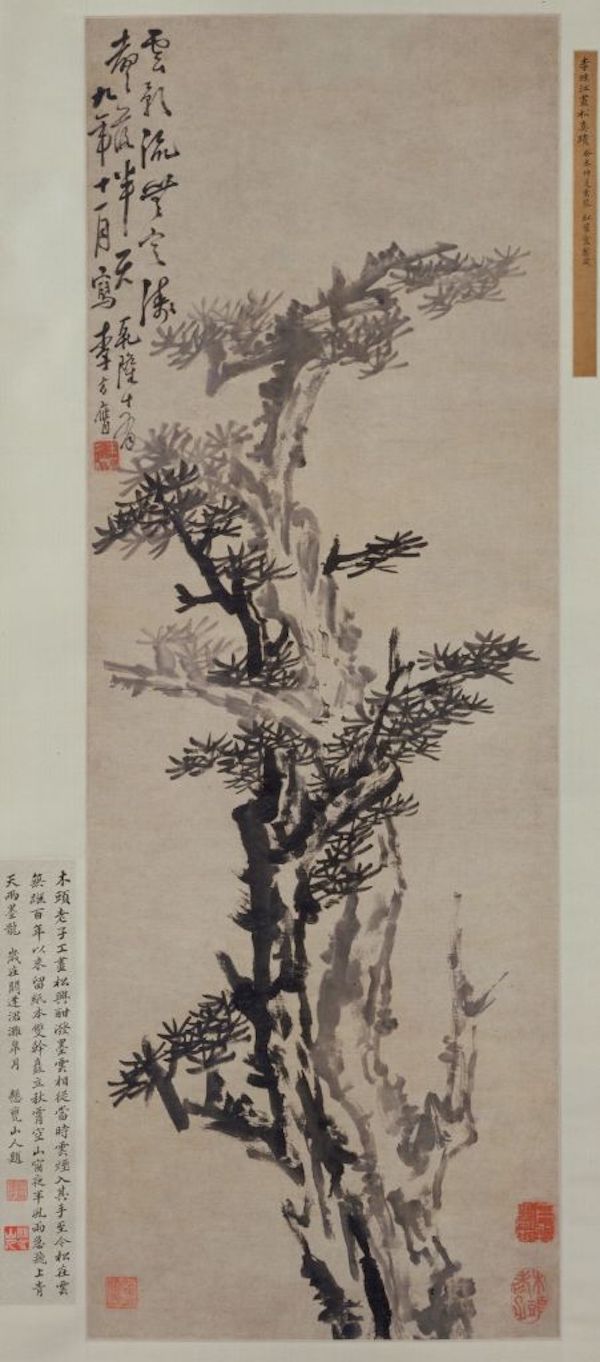
Qing Li Fangying Ink Brush Ancient Pine Figure Axis Collection of the Palace Museum
The picture draws an ancient pine, with a strong posture, as if an old man who has experienced vicissitudes of life stands in the wind in the painting. The whole layout is concise, the brushwork is vigorous, and the artistic conception is profound, showing the author's upright personality. It is a representative work of Li Fangying in his later years.
Zhao Zhiqian Mo Song Tu Axis
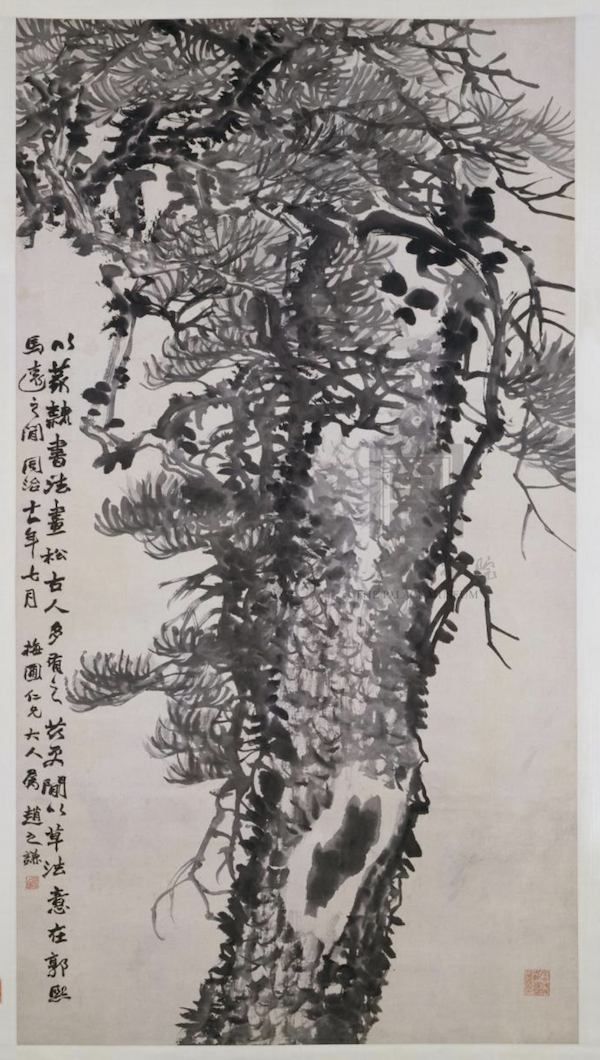
Zhao Zhiqian's ink pine scroll in the Qing Dynasty, collected by the Palace Museum
According to the artist's own title, this picture uses the calligraphy techniques of seal script, official script and cursive script to describe the pine tree. Tree trunks, branches, and pine needles are expressed in cursive brushwork, adhering to the bold and unrestrained tradition of literati painting. The brushstrokes inscribed in running script on the painting are vigorous and vigorous, and its charm of gold and stone complements the painting method of pine wood, which is full of interest. This painting is worthy of being Zhao Zhiqian's masterpiece of painting with gold, stone and calligraphy.
The signature of this painting is: "July, the eleventh year of Tongzhi, Mr. Mei Pu belongs to Mr. Zhao Zhiqian." Seal "Zhao Zhiqian Seal" Zhu Wenyin. The "Eleventh Year of Tongzhi" was 1872, when Zhao Zhiqian was 44 years old.
Wu Changshuo Cangsong Axis in the Republic of China

Wu Changshuo Cangsong Axis in the Republic of China Collection of the National Palace Museum, Taipei
This painting has Wu Changshuo's own cursive inscription: Yu Bo recites Tianbao vertically and horizontally. Nanshan and longevity have become a habit. Dai Ningshuangxue. Tao turned the stars. Autumn is old, the wind nests and the crane stabilizes the cliff. Shhh. Jackie Chan. Break the loneliness. Listening to string poetry outside the window. Cang Ran old man. Move the sea of clouds. Shake your elbows. Teng Gu Xiao opened his mouth wildly. Mang Tianya. Dare to try the ax jin. Whoever holds the Tang Du stone bed will be fine. Qin Feng Dongdai. How can the public have a long way to go. Just ask. Stay old and never travel. Zhen Zhuang asks to write the big banner and begs for two positives. Bingchen (1916) Summer. Wu Changshuo was seventy-three years old.
King Zhen Song of the Republic of China

The King of the Republic of China Zhensong Crane Axis Collection of the National Palace Museum, Taipei
This painting has the title of Wang Zhen's running script: The pines are uprooted from the ground and the sky is dry, and there is a long time of clear shade and green moss. In the middle of the night, the wind and waves are in harmony, and the thousand-year-old crane returns in the moonlight. Xin Wei (1931) belonged to Mr. Ueda. Written by Bailongshan people.
Fu Baoshi's Axis of Viewing Mountains by Pine Stream in Modern Times
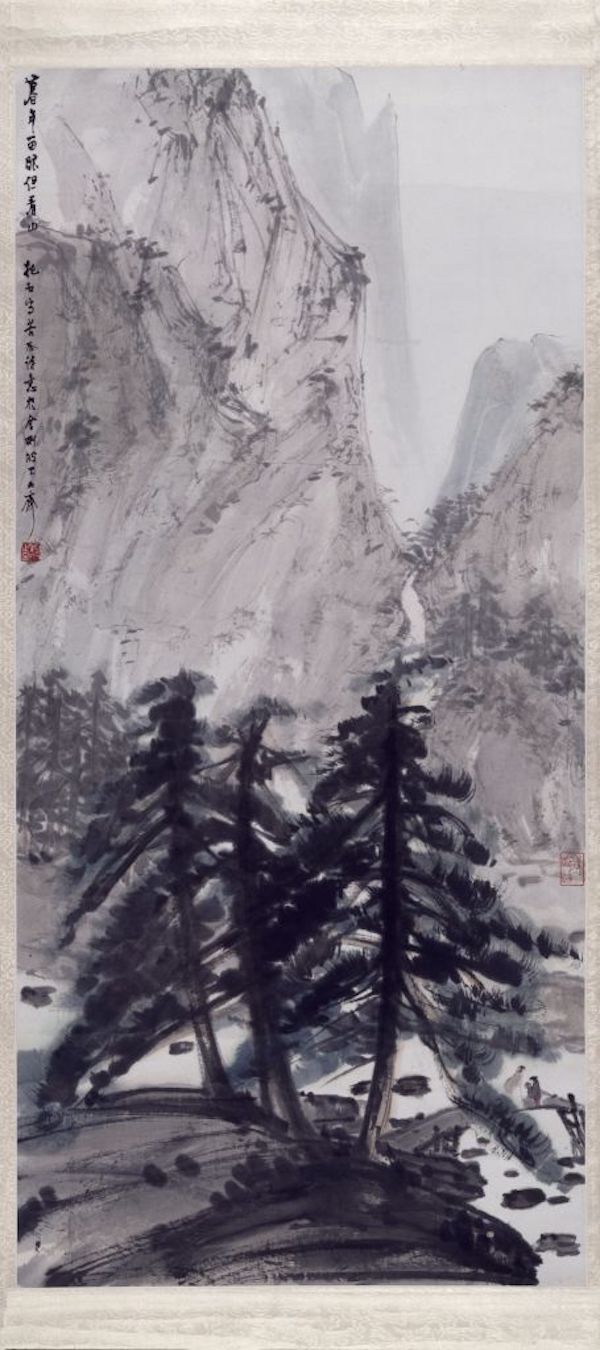
Fu Baoshi's Viewing Mountains by Pine Stream in Modern and Modern Times, Collection of the Palace Museum
The title of this painting: "Keep your eyes on the mountains in your old age. Baoshi writes bitter gourd poetry in the mountain house under Jingangpo. " The seal "Boshi's seal" is printed in white, and "Often Drunk" is printed in Zhu Wenchang.
The "bitter gourd" mentioned in the postscript refers to the bitter gourd monk, that is, Shi Tao, a painter in the late Ming and early Qing Dynasties.
The layout of this picture is dense, but you can see the peaks and ridges, the walls stand thousands of feet, a line of flying streams hangs upside down in the mountains, and the water merges into streams at the foot of the mountains, murmuring endlessly. The long pine is tall and straight, with numerous branches, which has the potential to cover the sky and block out the sun. The scribes stood on the Banqiao spanning the two banks and looked across the distance, as if they were overwhelmed by this natural picture.
This picture was donated by Fu Baoshi's wife, Luo Shihui.
(This article is compiled from relevant information on the official website of the National Palace Museum and the National Palace Museum in Taipei.)
